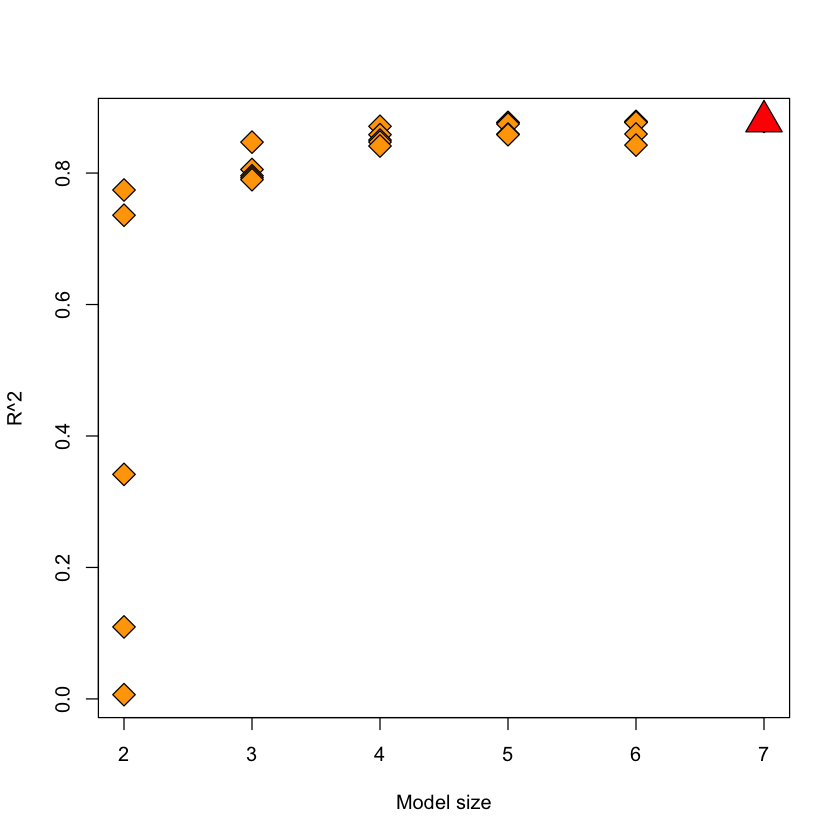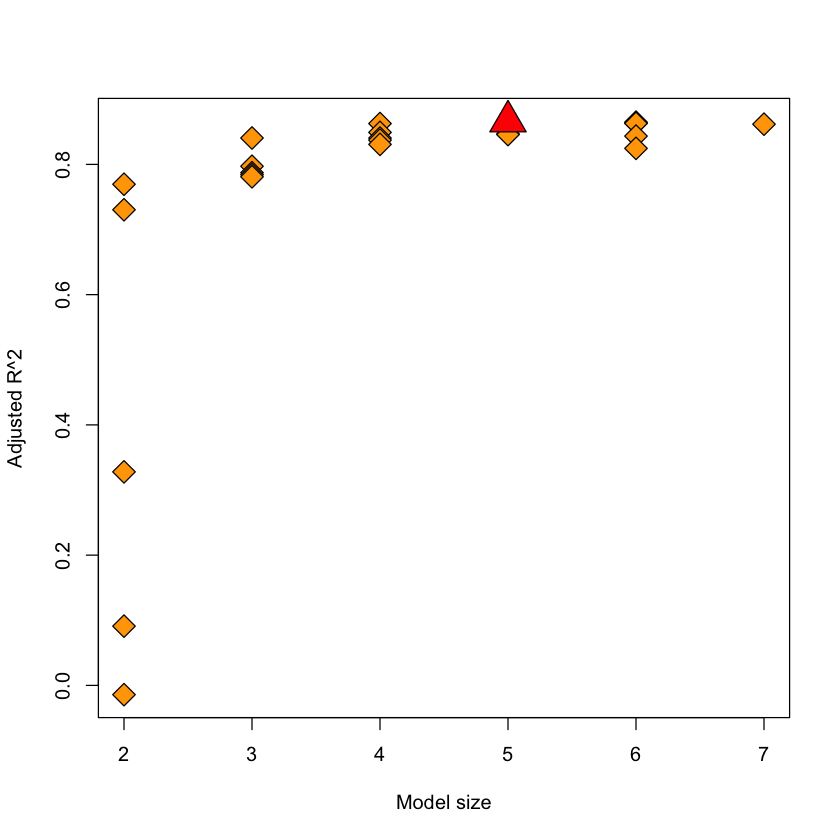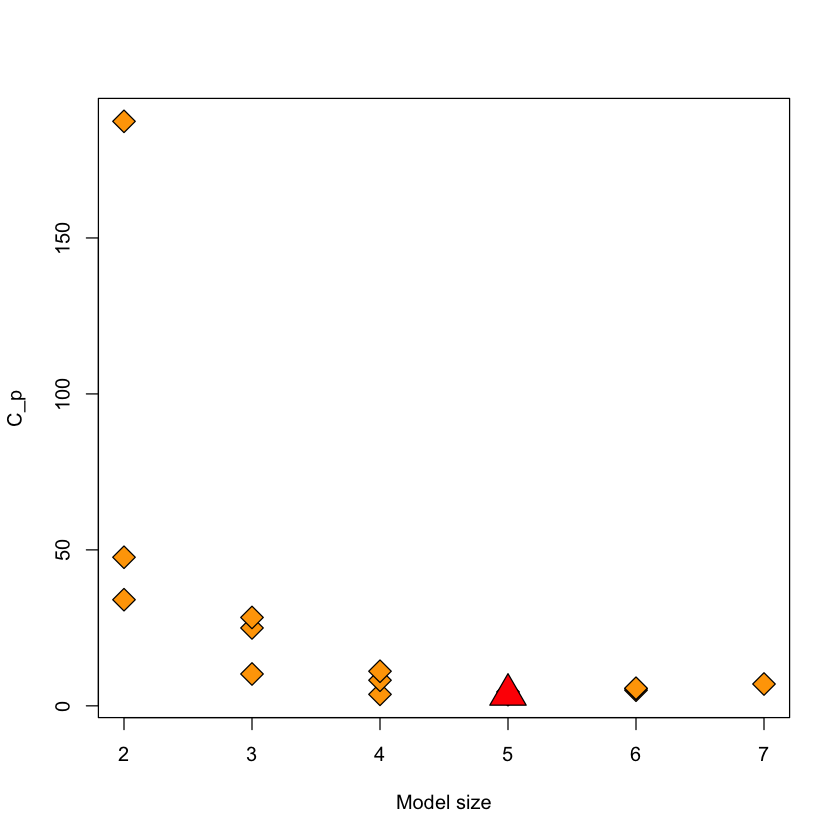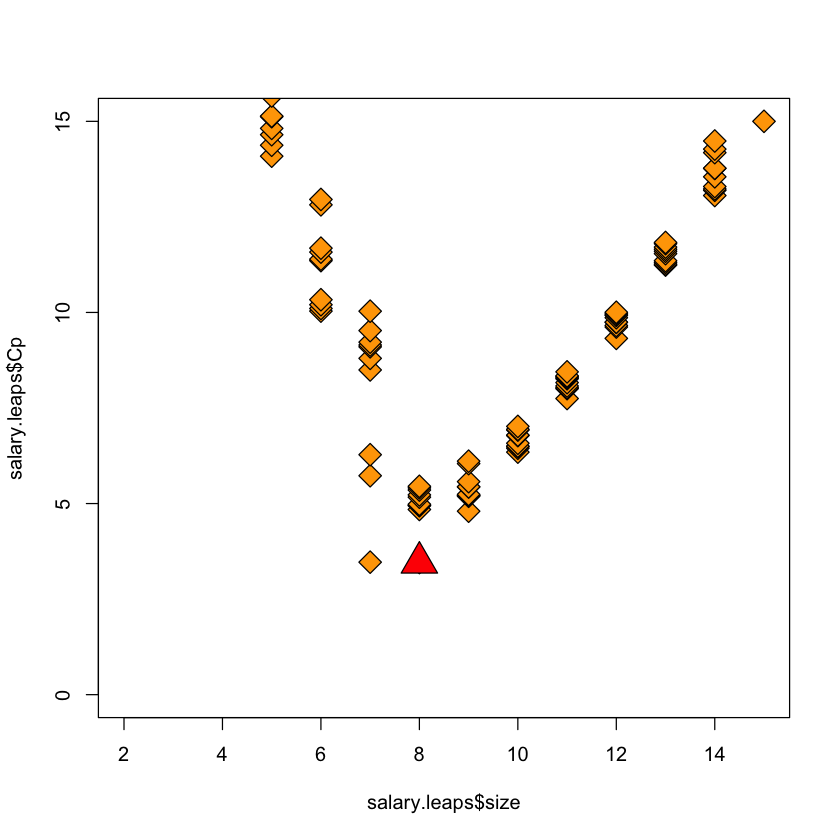Model selection#
Download#
Outline#
Case studies:
A. SAT scores by state
B. Deeper dive into sex discrimination in base salary
Model selection
Best subsets
Stepwise methods
Case study A: State SAT scores#
Predicting average 1982 SAT score by state.
Features:
Takers(percentage)Income(parental income of SAT takers)Years(years of education in key subjects)Public(percent of takers in public high school)Expend(state expenditure on high schools per student)Rank(average percentile of students writing SAT
SAT data#
url = 'https://raw.githubusercontent.com/StanfordStatistics/stats191-data/main/Sleuth3/state_SAT.csv'
SAT.df = read.csv(url, sep=',', row.names=1, header=TRUE)
head(SAT.df)
| SAT | Takers | Income | Years | Public | Expend | Rank | |
|---|---|---|---|---|---|---|---|
| <int> | <int> | <int> | <dbl> | <dbl> | <dbl> | <dbl> | |
| Iowa | 1088 | 3 | 326 | 16.79 | 87.8 | 25.60 | 89.7 |
| SouthDakota | 1075 | 2 | 264 | 16.07 | 86.2 | 19.95 | 90.6 |
| NorthDakota | 1068 | 3 | 317 | 16.57 | 88.3 | 20.62 | 89.8 |
| Kansas | 1045 | 5 | 338 | 16.30 | 83.9 | 27.14 | 86.3 |
| Nebraska | 1045 | 5 | 293 | 17.25 | 83.6 | 21.05 | 88.5 |
| Montana | 1033 | 8 | 263 | 15.91 | 93.7 | 29.48 | 86.4 |
Case study B: Sex discrimination in employment#
Same data as earlier, with additional features:
Age(years)Educ(years)Exper(months)Senior(months)Sal77(salary in 1977 – used for a different analysis in the book)
Salary data#
url = 'https://raw.githubusercontent.com/StanfordStatistics/stats191-data/main/Sleuth3/discrim_employment.csv'
salary = read.table(url, sep=',', header=TRUE)
head(salary)
| Bsal | Sal77 | Sex | Senior | Age | Educ | Exper | |
|---|---|---|---|---|---|---|---|
| <int> | <int> | <chr> | <int> | <int> | <int> | <dbl> | |
| 1 | 5040 | 12420 | Male | 96 | 329 | 15 | 14.0 |
| 2 | 6300 | 12060 | Male | 82 | 357 | 15 | 72.0 |
| 3 | 6000 | 15120 | Male | 67 | 315 | 15 | 35.5 |
| 4 | 6000 | 16320 | Male | 97 | 354 | 12 | 24.0 |
| 5 | 6000 | 12300 | Male | 66 | 351 | 12 | 56.0 |
| 6 | 6840 | 10380 | Male | 92 | 374 | 15 | 41.5 |
Model selection#
In a given regression situation, there are often many choices to be made. Recall our usual setup (with intercept)
Any subset \(A \subset \{1, \dots, p\}\) yields a new regression model
Why model selection?#
Possible goals in the SAT data#
States with low
Takerstypically have highRankBeyond this effect, what is important for understanding variability in SAT scores?
Maybe want a parsimonious model.
General problem & goals#
When we have many predictors (with many possible interactions), it can be difficult to formulate a good model from outside considerations.
Which main effects do we include?
Which interactions do we include?
Model selection procedures try to simplify / automate this task.
General comments#
This is generally an “unsolved” problem in statistics: there are no magic procedures to get you the “best model” or “correct model”.
Inference after selection is full of pitfalls!
General approach#
To “implement” a model selection procedure, we first need a criterion / score / benchmark to compare two models.
Given a criterion, we also need a search strategy.
Search strategies#
Exhaustive: With a limited number of predictors, it is possible to search all possible models.
Sequential: Select a model in a sequence of steps.
Exhaustive search (leaps in R)#
Candidate criteria#
\(R^2\): not a good criterion. Always increase with model size \(\implies\) “optimum” is to take the biggest model.
Adjusted \(R^2\): better. It “penalized” bigger models. Follows principle of parsimony / Occam’s razor.
Mallow’s \(C_p\) – attempts to estimate a model’s predictive power, i.e. the power to predict a new observation.
Setup for leaps#
# you may need to install `leaps` library
# install.packages('leaps', repos='http://cloud.r-project.org')
library(leaps)
leapstakes a design matrix as argument: throw away the intercept column or leaps will complain:
SAT.lm = lm(SAT ~ ., SAT.df)
X_SAT = model.matrix(SAT.lm)[,-1]
Y_SAT = SAT.df$SAT
The problem with R^2#
SAT.leaps = leaps(X_SAT, Y_SAT, nbest=5, method='r2')
r2_idx = which((SAT.leaps$r2 == max(SAT.leaps$r2)))
best.model.r2 = colnames(X_SAT)[SAT.leaps$which[r2_idx,]]
best.model.r2
- 'Takers'
- 'Income'
- 'Years'
- 'Public'
- 'Expend'
- 'Rank'
plot(SAT.leaps$size,
SAT.leaps$r2,
pch=23,
bg='orange',
cex=2,
ylab='R^2',
xlab='Model size')
points(SAT.leaps$size[r2_idx],
SAT.leaps$r2[r2_idx],
pch=24,
bg='red',
cex=3)

Figure#
Plot of \(R^2\) of a model as a function of the model size.
The “best” model in terms of \(R^2\) does indeed include all variables.
Adjusted \(R^2\)#
As we add more and more variables to the model – even random ones, \(R^2\) will increase to 1.
Recall that adjusted \(R^2\) tries to take this into account by replacing sums of squares by mean squares
SAT.leaps = leaps(X_SAT, Y_SAT, nbest=5, method='adjr2')
adjr2_idx = which((SAT.leaps$adjr2 == max(SAT.leaps$adjr2)))
best.model.adjr2 = colnames(X_SAT)[SAT.leaps$which[adjr2_idx,]]
best.model.adjr2
- 'Years'
- 'Public'
- 'Expend'
- 'Rank'
plot(SAT.leaps$size,
SAT.leaps$adjr2,
pch=23, bg='orange',
cex=2,
ylab='Adjusted R^2',
xlab='Model size')
points(SAT.leaps$size[adjr2_idx],
SAT.leaps$adjr2[adjr2_idx],
pch=24, bg='red', cex=3)

Figure#
Plot of \(R^2_a\) of a model as a function of the model size.
The “best” model in terms of \(R^2_a\) is not the full model: has size 5 (4 variables plus intercept)
Mallow’s \(C_p\)#
Definition:#
Notes:#
\(\widehat{\sigma}^2=SSE(F)/df_F\) is the “best” estimate of \(\sigma^2\) we have (use the fullest model), i.e. in the
SATdata it uses all 6 main effects.\(SSE({\cal M})\) is the \(SSE\) of the model \({\cal M}\).
\(p({\cal M})\) is the number of predictors in \({\cal M}\).
This is an estimate of the expected mean-squared error of \(\widehat{Y}({\cal M})\), it takes bias and variance into account.
SAT.leaps = leaps(X_SAT, Y_SAT, nbest=3, method='Cp')
Cp_idx = which((SAT.leaps$Cp == min(SAT.leaps$Cp)))
best.model.Cp = colnames(X_SAT)[SAT.leaps$which[Cp_idx,]]
best.model.Cp
- 'Years'
- 'Public'
- 'Expend'
- 'Rank'
plot(SAT.leaps$size,
SAT.leaps$Cp,
pch=23,
bg='orange',
cex=2,
ylab='C_p',
xlab='Model size')
points(SAT.leaps$size[Cp_idx],
SAT.leaps$Cp[Cp_idx],
pch=24,
bg='red',
cex=3)

Figure#
Plot of \(C_p\) of a model as a function of the model size.
The “best” model in terms of \(C_p\) is not the full model: has size 5 (4 variables plus intercept)
Agrees with
R^2_a.
Sequential search (step in R)#
The
stepfunction uses a specific score for comparing models.
Akaike Information Criterion (AIC)#
Above, \(L({\cal M})\) is the maximized likelihood of the model.
Bayesian Information Criterion (BIC)#
Note: AIC/BIC be used for whenever we have a likelihood, so this generalizes to many statistical models.
AIC for regression#
In linear regression with unknown \(\sigma^2\)
In linear regression with known \(\sigma^2\)
AIC is very much like Mallow’s \(C_p\) with known variance.
n = nrow(X_SAT)
p = length(coef(SAT.lm)) + 1
c(n * log(2*pi*sum(resid(SAT.lm)^2)/n) + n + 2*p, AIC(SAT.lm))
- 477.477004344384
- 477.477004344384
Properties of AIC / BIC#
BIC will typically choose a model as small or smaller than AIC (if using the same search direction).
As our sample size grows, under some assumptions, it can be shown that
AIC will (asymptotically) always choose a model that contains the true model, i.e. it won’t leave any variables out.
BIC will (asymptotically) choose exactly the right model.
SAT example#
Let’s take a look at step in action. Probably the simplest strategy
is forward stepwise which tries to add one variable at a time, as
long as it can find a resulting model whose AIC is better than its
current position.
When it can make no further additions, it terminates.
SAT.step.forward = step(lm(SAT ~ 1, SAT.df),
list(upper = SAT.lm),
direction='forward',
trace=FALSE)
names(coef(SAT.step.forward))[-1]
- 'Rank'
- 'Years'
- 'Expend'
- 'Public'
Interactions and hierarchy#
Wildcard:
.denotes any variable inSAT.dfexceptSAT.^2denotes all 2-way interactions
SAT2.lm = lm(SAT ~ .^2, SAT.df)
SAT2.step.forward = step(lm(SAT ~ 1, SAT.df),
list(upper = SAT2.lm),
direction='forward',
trace=FALSE)
names(coef(SAT2.step.forward))[-1]
- 'Rank'
- 'Years'
- 'Expend'
- 'Public'
- 'Years:Expend'
- 'Years:Public'
- 'Rank:Public'
Note: when looking at
trace=TRUEwe see thatstepdoes not include an interaction unless both main effects are already in the model.
BIC example#
The only difference between AIC and BIC is the price paid per
variable. This is the argument k to step. By default k=2 and for
BIC we set k=log(n). If we set k=0 it will always add variables.
SAT.step.forward.BIC = step(lm(SAT ~ 1, SAT.df),
list(upper=SAT.lm),
direction='forward',
k=log(nrow(SAT.df)),
trace=FALSE)
names(coef(SAT.step.forward.BIC))[-1]
- 'Rank'
- 'Years'
- 'Expend'
Compare to AIC#
names(coef(SAT.step.forward))[-1]
- 'Rank'
- 'Years'
- 'Expend'
- 'Public'
Backward selection#
Just for fun, let’s consider backwards stepwise. This starts at a full model and tries to delete variables.
There is also a direction="both" option.
SAT.step.backward = step(lm(SAT ~ ., SAT.df),
list(lower = ~ 1),
direction='backward',
trace=FALSE)
names(coef(SAT.step.backward))[-1]
- 'Years'
- 'Public'
- 'Expend'
- 'Rank'
Compare to forward#
names(coef(SAT.step.forward))[-1]
- 'Rank'
- 'Years'
- 'Expend'
- 'Public'
Summarizing results#
The model selected depends on the criterion used.
Criterion |
Model |
|---|---|
\(R^2\) |
~ |
\(R^2_a\) |
~ |
\(C_p\) |
~ |
AIC forward |
~ |
BIC forward |
~ |
AIC forward |
~ |
The selected model is random and depends on which method we use!
Pretty stable for this analysis.
Where we are so far#
Many other “criteria” have been proposed: cross-validation (CV) a very popular criterion.
Some work well for some types of data, others for different data.
Check diagnostics!
These criteria (except cross-validation) are not “direct measures” of predictive power, though Mallow’s \(C_p\) is a step in this direction.
\(C_p\) measures the quality of a model based on both bias and variance of the model. Why is this important?
Bias-variance tradeoff is ubiquitous in statistics!
Case study B: sex discrimination#
Possible goals in the salary data#
Interested in the effect of
Sexbut there could lots of other covariates we might adjust for…Considering all second order effects (besides
Sex) in salary: \(2^{14}\) models!Remove confounders, reduce variability of
Sexeffect.
Approach#
Fit a model without
Sexusing a model selection technique.Estimate the effect of
Sexby adding it to this model.
How are we going to choose \(2^{14}\) possible choices!
D = with(salary, cbind(Senior, Age, Educ, Exper))
base.lm = lm(Bsal ~ poly(D, 2), data=salary)
summary(base.lm)$coef
| Estimate | Std. Error | t value | Pr(>|t|) | |
|---|---|---|---|---|
| (Intercept) | 5582.2150 | 248.1313 | 22.4970203 | 7.638697e-36 |
| poly(D, 2)1.0.0.0 | -1573.9454 | 604.3710 | -2.6042704 | 1.101964e-02 |
| poly(D, 2)2.0.0.0 | -557.6906 | 598.3874 | -0.9319892 | 3.542180e-01 |
| poly(D, 2)0.1.0.0 | -3296.2869 | 1205.0112 | -2.7354823 | 7.708189e-03 |
| poly(D, 2)1.1.0.0 | -1391.7057 | 10662.3569 | -0.1305252 | 8.964870e-01 |
| poly(D, 2)0.2.0.0 | 642.9167 | 1481.8206 | 0.4338695 | 6.655809e-01 |
| poly(D, 2)0.0.1.0 | 2803.3752 | 624.6501 | 4.4879128 | 2.448263e-05 |
| poly(D, 2)1.0.1.0 | -8988.2242 | 5831.5630 | -1.5413062 | 1.272897e-01 |
| poly(D, 2)0.1.1.0 | -13458.5332 | 10422.6307 | -1.2912799 | 2.004204e-01 |
| poly(D, 2)0.0.2.0 | 511.2407 | 617.2702 | 0.8282284 | 4.100682e-01 |
| poly(D, 2)0.0.0.1 | 5148.9154 | 2440.3756 | 2.1098865 | 3.807450e-02 |
| poly(D, 2)1.0.0.1 | 3111.7689 | 11658.6746 | 0.2669059 | 7.902460e-01 |
| poly(D, 2)0.1.0.1 | -22769.0399 | 27351.7731 | -0.8324521 | 4.076954e-01 |
| poly(D, 2)0.0.1.1 | -5858.7426 | 9012.8843 | -0.6500408 | 5.175758e-01 |
| poly(D, 2)0.0.0.2 | -671.2631 | 1646.9549 | -0.4075783 | 6.846998e-01 |
Best second order model using \(C_p\) with leaps#
X_sal = model.matrix(base.lm)[,-1]
Y_sal = log(salary$Bsal)
salary.leaps = leaps(X_sal, Y_sal, nbest=10, method='Cp')
Cp_idx = which((salary.leaps$Cp == min(salary.leaps$Cp)))
best.model.Cp = salary.leaps$which[Cp_idx,]
colnames(X_sal)[best.model.Cp]
- 'poly(D, 2)1.0.0.0'
- 'poly(D, 2)0.1.0.0'
- 'poly(D, 2)0.0.1.0'
- 'poly(D, 2)1.0.1.0'
- 'poly(D, 2)0.1.1.0'
- 'poly(D, 2)0.0.0.1'
- 'poly(D, 2)0.1.0.1'
Plot of \(C_p\) scores (Fig 12.11 in book)#
plot(salary.leaps$size,
salary.leaps$Cp,
pch=23,
bg='orange',
cex=2,
ylim=c(0, 15))
points(salary.leaps$size[Cp_idx],
salary.leaps$Cp[Cp_idx],
pch=24,
bg='red',
cex=3)

Figure:#
Plot of \(C_p\) score as a function of model size.
Two models are lower than the rest but quite close. These models used in subsequent analysis.
Estimating the effect of Sex#
summary(lm(log(Bsal) ~ Sex + X_sal[,best.model.Cp], data=salary))$coef['SexMale',]
- Estimate
- 0.117337805016164
- Std. Error
- 0.0229093663345294
- t value
- 5.12182673683605
- Pr(>|t|)
- 1.89648601842772e-06
On inspection, book drops one of these interactions:
summary(lm(log(Bsal) ~ Sex + X_sal[,best.model.Cp][,-4], data=salary))$coef['SexMale',]
- Estimate
- 0.119590116093162
- Std. Error
- 0.0229149605616616
- t value
- 5.21886632845638
- Pr(>|t|)
- 1.25496659910706e-06
What if we used step?#
step_df = with(salary, data.frame(Bsal, X_sal))
step_lm = lm(log(Bsal) ~ ., step_df)
step_sel = step(lm(log(Bsal) ~ 1, data=step_df),
list(upper=step_lm),
trace=FALSE)
names(coef(step_sel))[-1]
- 'poly.D..2.0.0.1.0'
- 'poly.D..2.1.0.0.0'
- 'poly.D..2.0.1.1.0'
- 'poly.D..2.0.0.0.1'
- 'poly.D..2.0.1.0.0'
- 'poly.D..2.0.1.0.1'
- 'poly.D..2.1.0.1.0'
Larger example#
As \(p\) grows,
leapswill be too slowEven
stepcan get slow
HIV resistance#
Resistance of \(n=633\) different HIV+ viruses to drug 3TC.
Features \(p=91\) are mutations in a part of the HIV virus, response is log fold change in vitro.
url_X = 'https://raw.githubusercontent.com/StanfordStatistics/stats191-data/main/NRTI_X.csv'
url_Y = 'https://raw.githubusercontent.com/StanfordStatistics/stats191-data/main/NRTI_Y.txt'
X_HIV = read.table(url_X, header=FALSE, sep=',')
Y_HIV = read.table(url_Y, header=FALSE, sep=',')
Y_HIV = as.matrix(Y_HIV)[,1]
X_HIV = as.matrix(X_HIV)
dim(X_HIV)
- 633
- 91
D = data.frame(X_HIV, Y_HIV)
M = lm(Y_HIV ~ ., data=D)
M0 = lm(Y_HIV ~ 1, data=D)
system.time(MF <- step(M0,
list(lower=M0,
upper=M),
trace=FALSE,
direction='both'))
names(coef(MF))
user system elapsed
0.607 0.017 0.629
- '(Intercept)'
- 'V68'
- 'V17'
- 'V19'
- 'V23'
- 'V54'
- 'V67'
- 'V82'
- 'V32'
- 'V81'
- 'V87'
- 'V57'
- 'V41'
- 'V31'
- 'V29'
- 'V30'
- 'V70'
- 'V39'
- 'V26'
- 'V69'
- 'V40'
- 'V62'
- 'V64'
- 'V80'
system.time(MB <- step(M,
list(lower=M0,
upper=M),
trace=FALSE,
direction='both'))
names(coef(MB))
user system elapsed
12.363 0.132 12.674
- '(Intercept)'
- 'V17'
- 'V19'
- 'V23'
- 'V26'
- 'V29'
- 'V30'
- 'V31'
- 'V32'
- 'V39'
- 'V40'
- 'V41'
- 'V54'
- 'V57'
- 'V62'
- 'V64'
- 'V67'
- 'V68'
- 'V69'
- 'V70'
- 'V80'
- 'V81'
- 'V82'
- 'V87'
